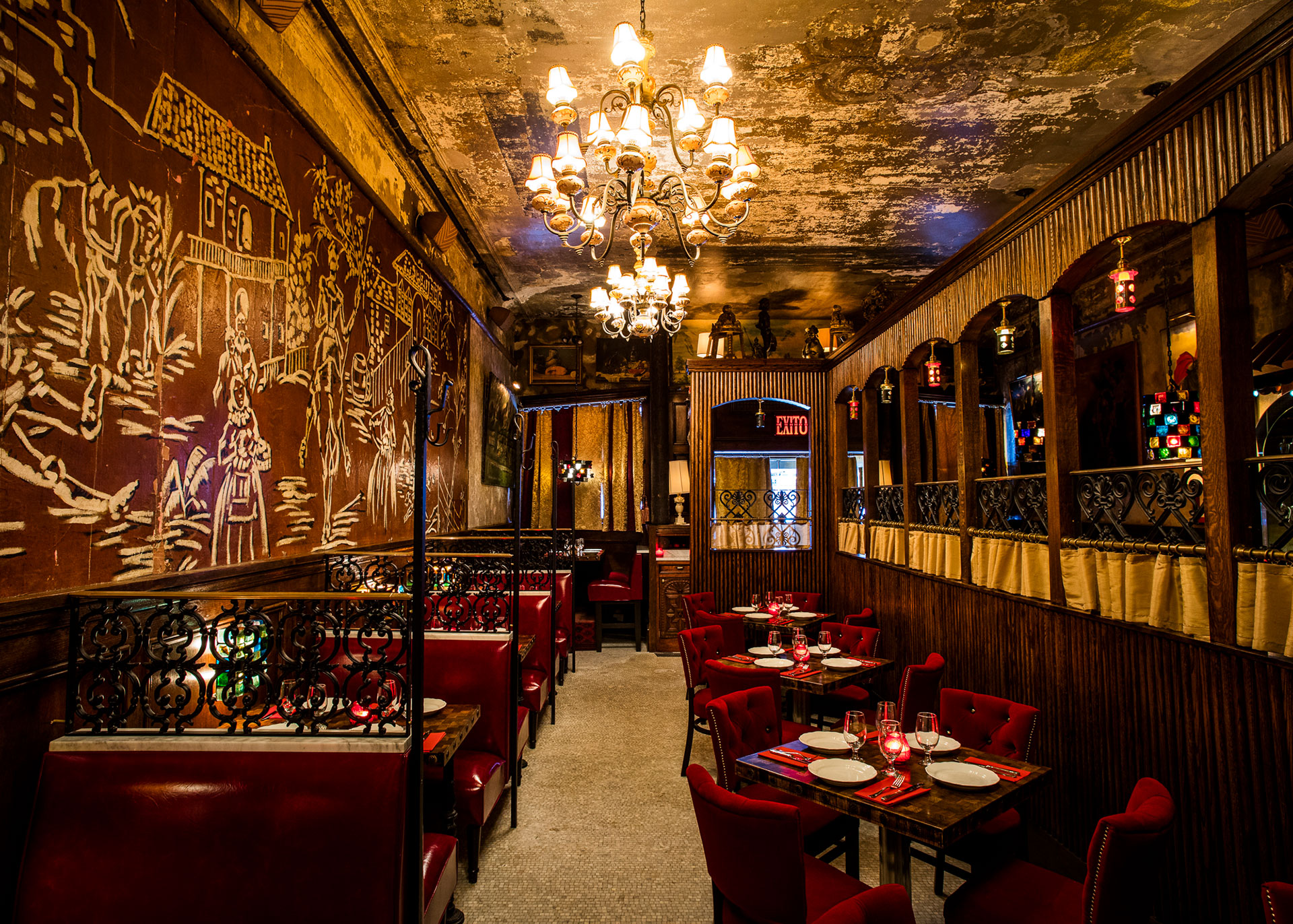New York’s most famous hotel is back

The Chelsea Hotel is one of those interesting thought experiments about the good old days of New York City—about wishing you were there when everything was happening, before everything changed, before there were banks and Starbucks and Pilates studios on every corner. On the surface, the Chelsea’s story reads like a fairy tale, an almost too-perfect fusion of place and personalities. But while many of the guests were glamorous, even in its heyday the hotel wasn’t exactly a bastion of first-class accommodations. Some rooms, like the one Leonard Cohen rented during his affair with Janis Joplin—immortalized in the song “Chelsea Hotel #2″—were shabby and dated even by 1968 standards, and not much has changed in the years since.
None of that ever mattered, though. The Chelsea was a “house of infinite tolerance,” where the maids rarely used their vacuum cleaners, as Arthur Miller explained in his essay “The Chelsea Affect.” Residents took out of each room what they put into it, creating a DIY wonderland from the bones of the grand old building. The grit and soul of its residents made the hotel legendary, just like Soho lofts in the ’80s, the elevator-less Village apartments in the ’60s, or the Williamsburg warehouses in the 2000s. To relive those times is to want to be young again, when we were happy to forgo certain amenities for action and intrigue and the promise that we would have absolutely no idea what might happen next.
But do we really want to go back there? Or do we just want to be tourists, experiencing the good times and skipping all the boring and unpleasant parts? Because the Chelsea Hotel is not only the place where Bob Dylan stayed up for days to write “Sad Eyed Lady of the Lowlands” for his new wife Sara, it’s also the place where Miller revived the spirit of Marilyn Monroe for his play “After the Fall” and Patti Smith came of age with Robert Mapplethorpe. It’s also the place where Dee Dee Ramone attracted heroin addicts like a magnet, where Dylan Thomas spent his last agonizing days, and where Nancy Spungeon bled to death from a stab wound to the stomach. We ask again: Do we really want to go back there?


Pop mythology and controversial reinvention
These are the questions the new Chelsea is asking. Not explicitly, but simply because the iconic property has been irrevocably changed—reinvented by renowned hoteliers Sean MacPherson, Ira Drukier, and Richard Born as the kind of impossibly cool luxury boutique hotel they specialize in. To call this new direction controversial would be an understatement. There were plenty of people (most notably the Chelsea’s longtime tenants) who wanted the hotel to stay as it is, accessible to a whole new generation of artists. That’s a noble goal to support—though it’s not clear it was ever in the cards. New York is different, and even the same old places aren’t the same anymore. For New York in the early 21st century, the Chelsea’s evolution is one to be expected, much like the early 20th century shift from co-op housing to extended-stay hotels.
Ironically, but inevitably, this is the era the owners here most strongly represent. Their Hotel Chelsea actually goes back – back before the celebrity parades, to a time more reminiscent of its founding than its later bohemian days. It draws on its pop mythology but is not dependent on it. It is a new beginning for the hotel, a new chance to write another hundred years of cultural history. Precisely because of the context, the Chelsea is one of the most celebrated hotel openings in decades.










This historic restoration is sorely needed in the American hotel industry—especially when compared to the hotels one can easily find in France or Italy, for example. This country does not yet have as many historic generational hotels as countries where centuries-old properties are steeped in historical eras and guest lists dating back to kings and queens. Here, the most famous hotels are notable not so much for their age or nobility as, let’s face it, for the untamed behavior of their most notorious guests. The Chelsea combined this libertinism with an incredible track record of artistic achievement. In addition to Dylan and Miller, Thomas Wolfe wrote “You Can’t Go Home Again” at the Chelsea. Jack Kerouac wrote parts of “On the Road” here. Warhol filmed here, and Arthur C. Clarke worked on the screenplay for “2001: A Space Odyssey” here. And the list goes on.
Tracing the hotel’s history is like drawing a line through American pop culture, from Mark Twain to Madonna—they all stayed at the Chelsea, and many spoke of it in sometimes glowing, sometimes apocalyptic terms, always in a way that painted a picture of a vibrant and creatively fertile community jumping from one history-rich era to the next. The last decade was not one of them. After a 2011 sale and a heated dispute between the owners, the Hotel Chelsea was a run-down, landmarked building with a 120-year legacy that had nearly ground to a halt. In 2022—under the same management as longtime favorites like the Maritime and the Bowery—it was without a doubt the most exciting brand-new old hotel to open in New York City. Just two years later, it lived up to its incredible expectations, earning a coveted MICHELIN Key.
Not everything has changed at the Chelsea. The lobby is less chaotic than it once was and still a mix of modern and abstract artwork, gifts from guests and tenants from years past who were known to pay with paintings when money was tight. This continues upstairs, where you no longer hear William Burroughs muttering through the hallways, but instead rooms adorned with art from the hotel’s endless collection, retaining the hotel’s long-standing spirit but with a little more sense of interior design.


Like a New York apartment (if it had its own bar scene)
Room types range from the modest Petite Chelsea to the sprawling Two Bedroom Suite. But in both – and all the accommodations in between – there’s a standard style that oozes bohemian, with purple carpets and leopard-print chairs matching soft headboards decorated like a paint-splattered canvas. The curtains aren’t torn to shreds, as they might have been in the Sex Pistols era, but they’re pockmarked with tiny holes the size of pennies, in an artful nod to rock star destruction. The effect is a beautiful, dappled light that gently falls into your room at sunrise.
All of this adds up to a Hotel Chelsea that feels more like an eclectic New York apartment building than one of the trendiest hotels. You’ll even find a true Zen moment on the roof, a beautiful penthouse spa with its own terraced garden.
That’s true from the second floor upwards. The first floor is less quiet. The Lobby Bar is undeniably a trendy hangout, the kind of place where you’ll find a woman in a fur coat sipping on a cigarette between sips of a signature martini. Cafe Chelsea is the more casual French-American bistro, and El Quijote is the historic restaurant (first opened in 1930) that still has its long windmill mural and Spanish menu.
Locals will want to make reservations at these establishments, otherwise they will be turned away almost every weekend. Hotel guests, however, are lucky to get priority access. The Chelsea Hotel keeps a few tables open for guests who call in at short notice looking for accommodation.
Besides all that it has to offer, the new Hotel Chelsea has breathed new life into this little stretch of 23rd between Seventh and Eighth, making it chicer than ever before. And of all the new amenities, it’s the revamped iron balconies that wrap around the iconic red brick facade that make the new old hotel poetically understandable. Original balconies were known for their lack of partitions—guests’ pets could wander from room to room. Today’s hotel takes pride in these wonderful outdoor spaces, but hopes to create some demarcation between them. It’s an apt metaphor—if not quite Dylan-worthy—for the new era at 222 W. 23rd.
Book Hotel Chelsea with the MICHELIN Guide →


Photography by Annie Schlechter and Eric Medsker




